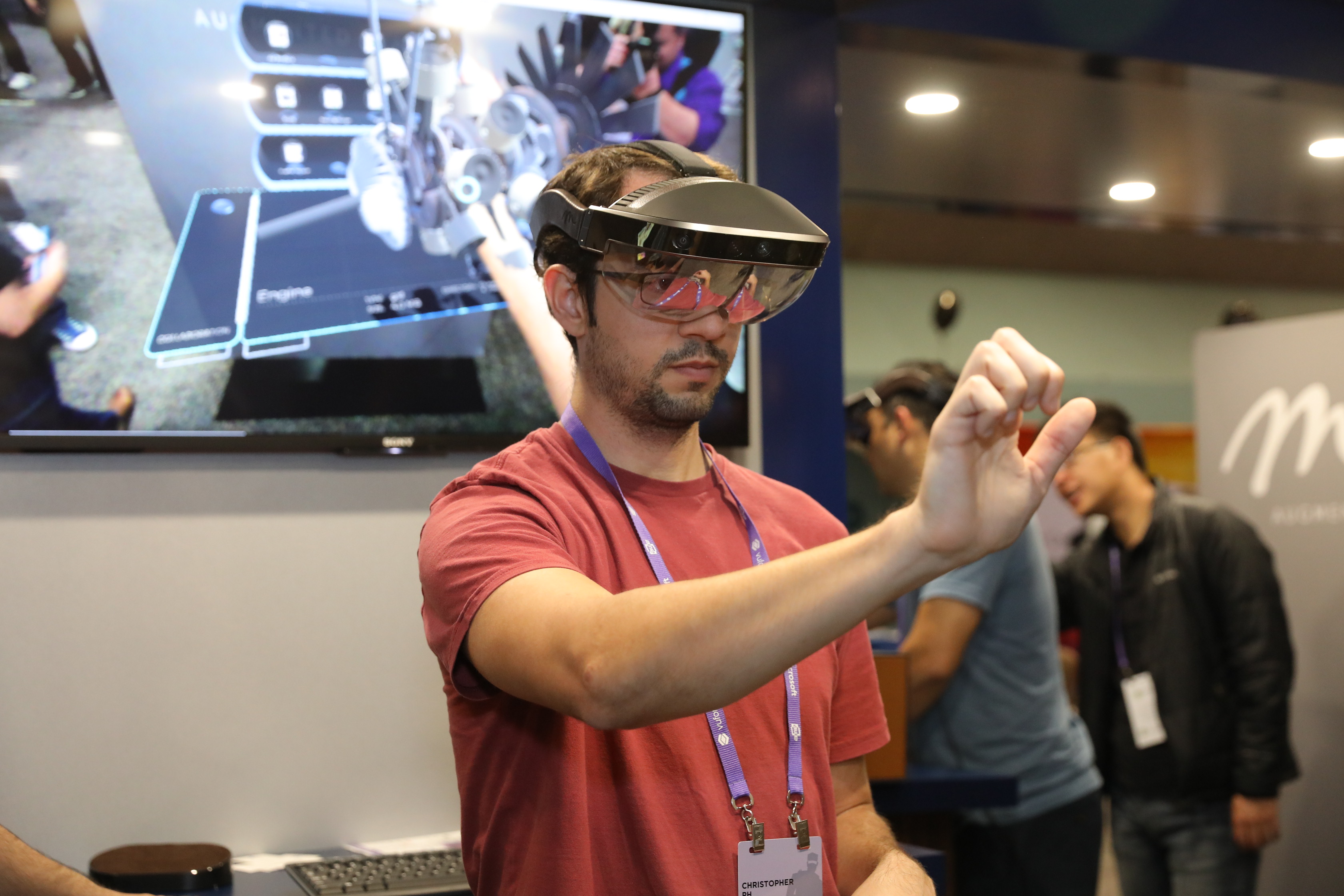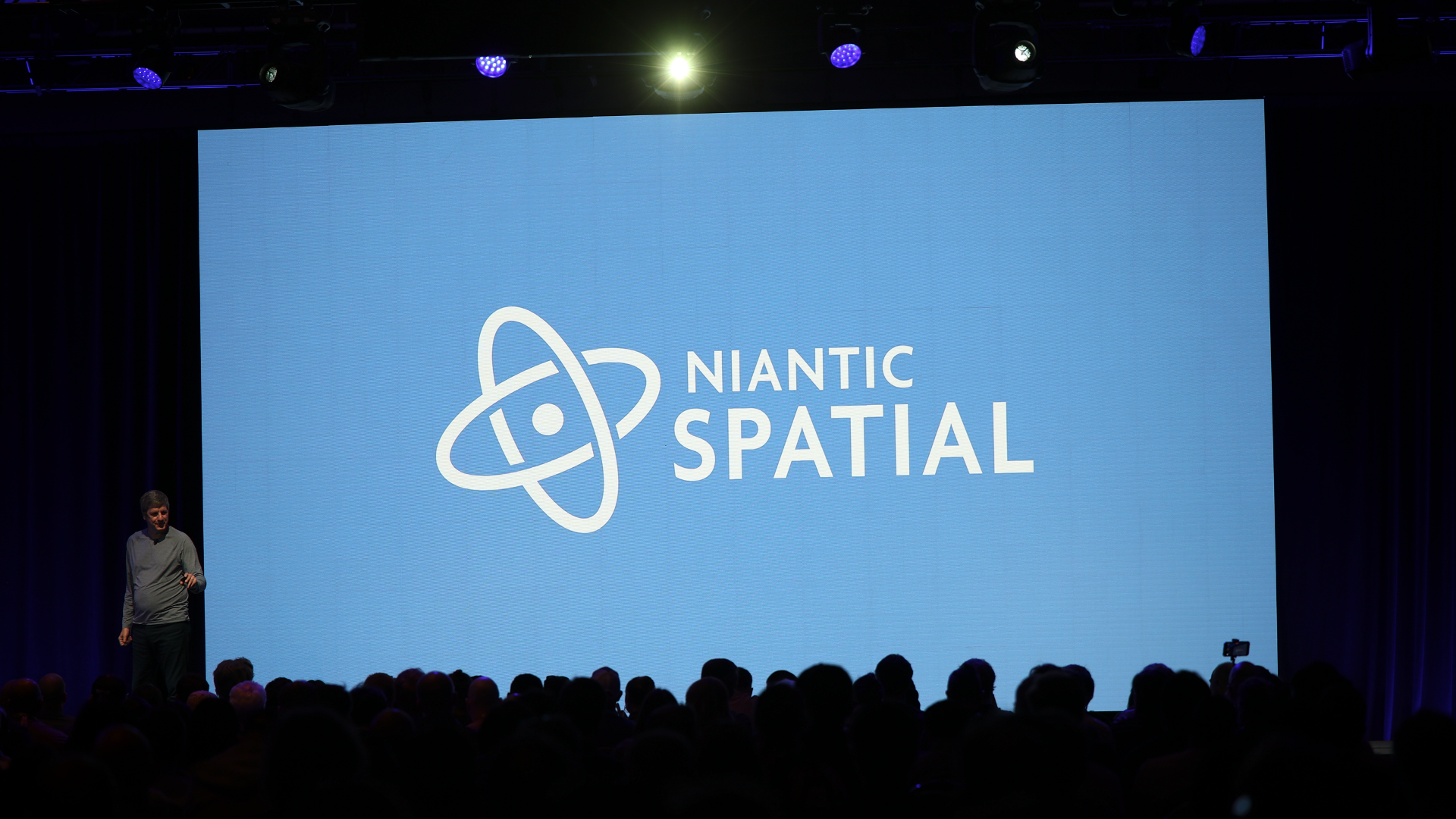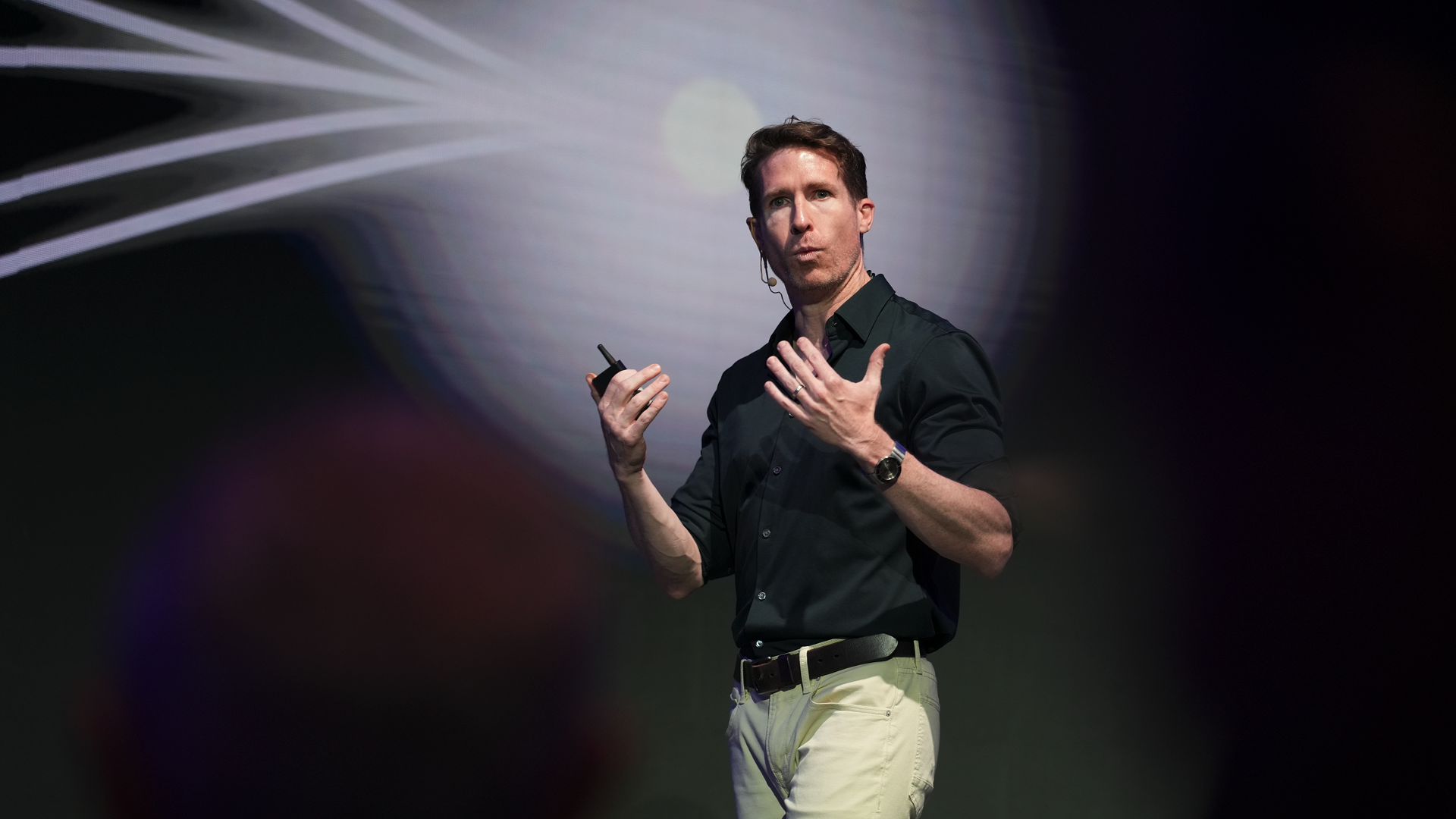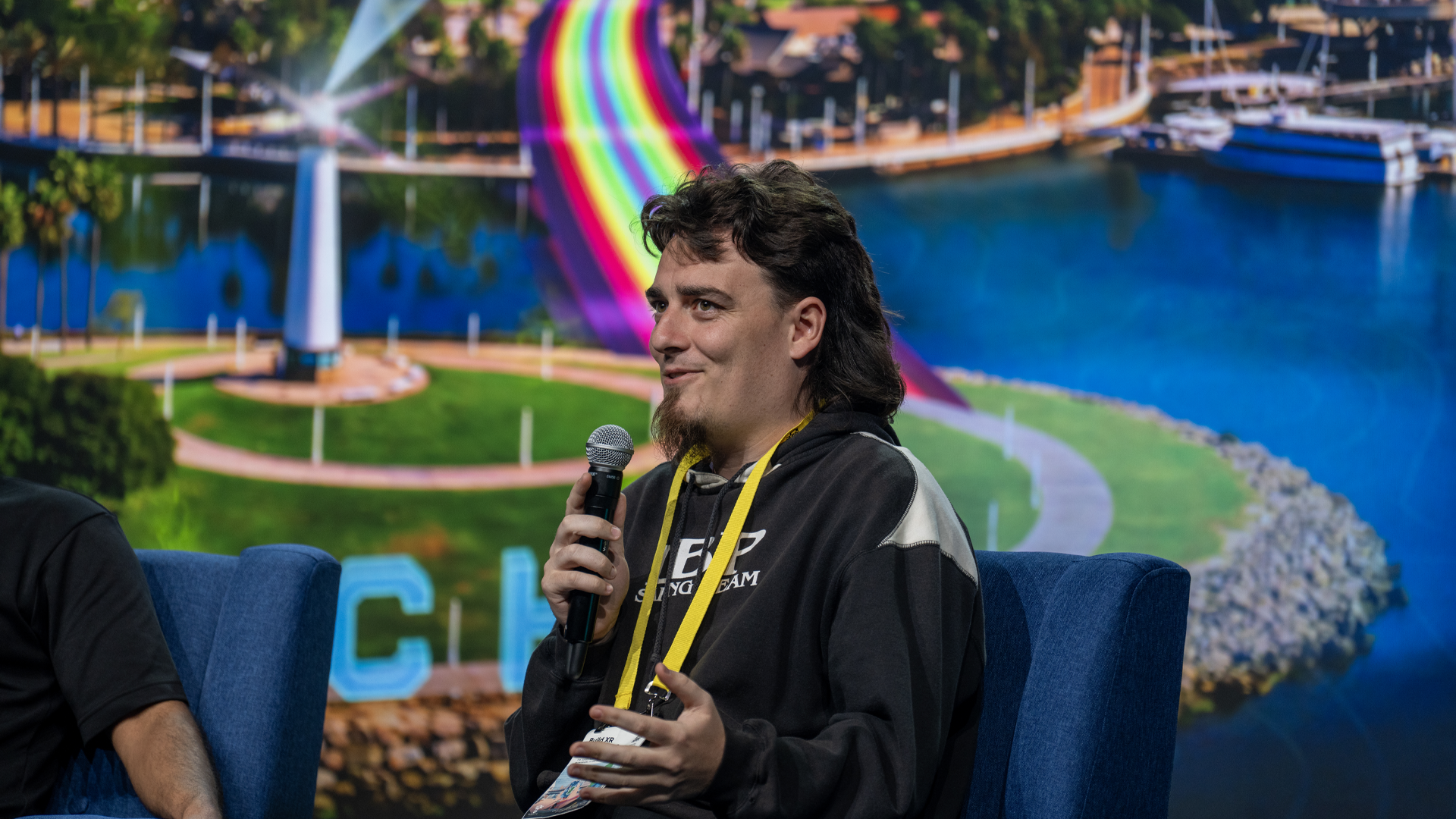If you made it with us from the first keynote at 9am to the end of the AWE USA Official After Party sponsored by DAQRI at the Corinthian Grand Ballroom, congratulations! Please get yourself two cups of coffee before the final day of the show!
In addition to a packed program that emphasized using XR for good, the Expo Hall and Playground opened on Thursday. There were tons of demos to try, bizarre and exciting immersive experiences, startup pitches, more Circuit Stream workshops on creating apps for the HTC Vive and Windows Mixed Reality, Happy Hour with food sponsored by Bosch right inside the Playground, and the annual Auggie Awards Ceremony.
The day began with two stellar back-to-back keynote presentations in the Mission City Ballroom: Pixar veteran Jason Katz made us all nostalgic in his presentation powered by Prezi. "Good storytelling is achieved today the same way it was done a thousand years ago." Taking the stage after Jason, Qualcomm's Hugo Swart talked about building an ambient world and the possible convergence of MR devices in the next 10 years.
"XR is the future of mobile computing. It's going to change the way we work. It's going to change the way we play. It's going to change the way we socialize. The question is: How are we going to get there?"
Up next was the annual AWE Press Conference. Check out the highlights here.
On the other tracks, Erin Pangilinan of HARP shared UI device for immersive data visualization and Dr. Eliza Du from Integem Inc. talked about creating holographic AR, which doesn't require glasses, phones or apps for users to experience, on the Design Track. Kicking off the Work Track, Allan Cook shared some digital reality use cases Deloitte clients are building out today and PTC's Marc Shuetz spoke about scaling AR across enterprise. Mitchell Reifel of pmdtechnologies gave an inspiring talk on the future of 3D depth sensing on the Develop Track, and OmbiVirt's Michael Rucker shared his top 3 lessons for XR in the advertising industry with Amy Peck of Endeavor soon after discussing curiosity and wonder and educating the next generation with XR on the Life Track.
Today was also the first day of the XR4GOOD Track presented by Virtual World Society--52-year XR vet and legend Tom Furness welcomed attendees to the program. Subjects addressed over the course of the day included using VR to fight hate and make real social change, preserve the past for future generations, open hearts and minds and spread LGBTQ pride, save the honey bee, comfort children post-op, and teach ethical behavior.
In Design, Vertical's Neil Mathew talked about AR as a UI for the physical world, about creating a clickable interface in the real world and the balance of UI/reality; and Erik Murphy-Chutorian from 8th Wall shared design guidelines for mobile AR. "Magic wands are better than touchscreens." - Erik Meanwhile in Develop, Paul Chen walked listeners through how DAQRI Tag allows you to attach critical info, notes or multimedia to real-world facilities, objects and assets to manage operations at a glance; and Kim Pallister of Intel imagined the future of AR in 2025 (Life Track).
Following lunch were some incredible panels: XR writer/producer Maggie Lane, Warner Bros.' Greg Geqickey, Chris Young from Nickelodeon, and others talked about entertainment in the XR era on the Inspire Stage; followed by a panel of passionate journalists - Brian Blau from Gartner, Futurist Charlie Fink, Rachel Metz of MIT Technology Review, and Bloomberg's Mark Gurman - looking behind the hype of XR. In Work, a panel of leaders from Johnson & Johnson, Plex, Lockheed Martin, AGCO and Deloitte spoke about XR in manufacturing; soon followed by another panel on remote collaboration and documentation with XR.
Other informative panels across the six tracks included one on building the AR Cloud; and one on haptics to feel virtual worlds with Gijs den Butter (Sense Glove), Joe Michaels (HaptX), Di Dang (Google), Adrienne Hunter (OSSO VR), and Tom Carter (Ultrahaptics): "Haptics is the missing link to immersion." HP's Joanna Popper led a panel on location-based entertainment for driving consumer XR adoption: "Leverage AI, haptics and facial recognition to marry the content, vision and storytelling." And, after the afternoon break, an incredible panel on diversity in XR created a lot of buzz on Twitter.
"It's a new day in Silicon Valley, and you can no longer think that there aren't qualified candidates that look like us on this stage" - Christopher Lafayette, The Armada
"There's a lot of fear in talking about our own blind spots, but we need to talk about our own biases and do the deep, hard work." - Martin Welkhoff, WXR
Closing out the day, Unity's Tony Parisi talked about what's next for AR on the Main Stage. A panel of amazing women discussed tough issues in immersive experience design on a panel about empathy, empowerment and embodiment in VR; Rajiv Tiwari from Johnson & Johnson told us not to be afraid of the changes taking place in enterprise; and Xesto's Sophie Howe talked about the future of gestures.
The Inspire Stage closed with three excellent presentations by Ted Schilowitz from Paramount, 6d.ai's Matt Miesnieks, and Ramesh Raskar from MIT Media Lab. Ted gave us a tour of magical devices; Matt assured us that the AR Cloud infrastructure will connect today's disconnected AR apps and allow for sharing; and Ramesh spoke about farmers using AR to train and interact with data to make better decisions.
Lastly, here are some impressions and moments from AWE attendees on the Expo Floor: @jacob, @DisruptTweet, @mixtreality and E_Scallon.



